This paradox makes senescent cells a double-edged sword: necessary for short-term health but harmful in the long run. Because of this, scientists are now exploring new ways to support long-term health using senolytics, which are drugs designed to clear senescent cells, slow signs of aging, and extend your healthspan in the process. Below, we explore the science of senescent cells, including what they are, how they impact aging, and the most recent research aimed at eliminating them.
What are Senescent Cells?
Healthy cells in your body divide through a process called mitosis, which occurs when one cell splits into two cells to support growth, maintenance, and repair. In contrast, senescent cells permanently stop dividing but don't actually die the way they should. Instead, these cells remain active and continue pumping out chemicals that can increase inflammation, earning them the nickname "zombie cells." (1)
Senescent cells often get a bad rap, but they're actually pretty important to many aspects of health across your lifespan, from embryonic development to wound healing. They also act as a temporary stop sign, putting a pause on cell division to prevent issues. However, the trouble comes when they stick around too long. In fact, research shows that senescent cells can actually accelerate aging and drive the development of chronic disease. (2)
Causes of Cellular Senescence
Senescence can be triggered by stress, developmental signals, and internal or external stimuli. According to a 2021 review in Frontiers in Cell and Developmental Biology, some of the potential causes of cellular senescence include (3):
-
Shortened telomeres
-
Chromosome damage
-
Cancer
-
Radiation
-
Chemotherapy
-
Stress from toxins or free radicals
-
Changes in gene activity
-
Mitochondrial dysfunction
-
Inflammation
-
Tissue damage
-
Lack of nutrients
Senescence is clearly a complicated process, influenced by everything from your daily habits down to your DNA. Understanding exactly what sparks senescence is the first step in developing strategies that can help keep your cells healthy for longer.
Effects on Aging
As you get older, the senescent cells in your body start to steadily stack up. This is because your immune system and other processes like autophagy — which is responsible for clearing out old or damaged cells — become less efficient with age. (4) Plus, science shows that several other hallmarks of aging may be linked with cellular senescence too, including DNA damage, the shortening of the telomeres, and mitochondrial dysfunction. (5)
Senescent cells release a variety of compounds that can fuel inflammation and speed up aging, which are collectively known as senescence-associated secretory phenotypes (SASPs). (6) The build-up of senescent cells can also disrupt the function of other surrounding tissues and stall stem cells by interfering with the signals they need to keep tissues healthy and repair damage. Beyond pharmaceutical interventions, research into nutritional compounds has revealed that CoQ10 supplementation reduced cellular senescence at various stages in animal models of accelerated aging, as explored in our comprehensive analysis of CoQ10's anti-aging mechanisms. (7)
Senescent cells and the harmful substances they release play a key role in a wide range of age-related conditions, including (8):
-
Osteoporosis
-
Heart disease
-
Arthritis
-
Lung fibrosis
-
Kidney disease
-
Neurodegenerative disorders
-
Fatty liver
-
Metabolic dysfunction
Early research in mice suggests that therapies aimed at targeting senescent cells could help prevent, delay, or treat these conditions and may even hold the secret to slowing signs of aging in humans. (8)
Senolytics: A Breakthrough in Longevity Science
Senolytics are a new class of drugs designed to target and clear out senescent cells. By selectively eliminating these damaged cells, senolytics offer a promising way to slow the aging process, alleviate inflammation, and protect against disease. (9)
Many of these medications are repurposed anticancer drugs, which work by interfering with specific pathways in the body that trigger apoptosis (aka cell death) in senescent cells. Not only that, but some types of senolytics boast even more added health benefits, thanks to their antioxidant and anti-inflammatory effects. (10)
Senolytic drugs have delivered exciting results in animal studies, showing potential to boost longevity. For instance, one animal model found that dasatinib and quercetin (two senolytics) reduced age-related increases in markers of aging, including certain pro-inflammatory SASP genes. Not only that, but they were also able to enhance metabolic function in old age and reduce inflammation in fat tissue. (11)
In another animal study, researchers transplanted senescent cells into mice, leading to persistent physical decline in young mice and a shortened lifespan in older ones. Interestingly, treatment with dasatinib and quercetin actually improved physical function, extended survival after treatment by 36%, and lowered the risk of death to 65%. (12)
A 2024 review turned up similar findings, noting that fisetin (another type of senolytic) could effectively target and eliminate senescent cells. In addition to decreasing the viability and number of senescent cells, they concluded that fisetin could also lower levels of SASPs, leading to improved tissue health and a longer lifespan in animal studies. (13)
Human research is still in short supply, but early clinical trials show promise. In a study in people with diabetic kidney disease, dasatinib and quercetin reduced senescent cells, lowered markers of inflammation, and decreased immune cell activity linked to aging after just 11 days. (14) Even more exciting new research in humans is also already on the way, exploring how senolytics could combat frailty, COVID-19, Alzheimer's, and more. (9)
Conclusion
Senescent cells play a complex role in aging and can accumulate over time due to a long list of factors, including DNA damage, oxidative stress, and mitochondrial dysfunction, among others. Although these cells play an important role in health and can prevent damaged cells from dividing, they could also contribute to chronic inflammation, tissue dysfunction, and many age-related diseases. Fortunately, senolytics are emerging as a game-changer for longevity, clearing out aging cells to pave the way for a longer, healthier life.




